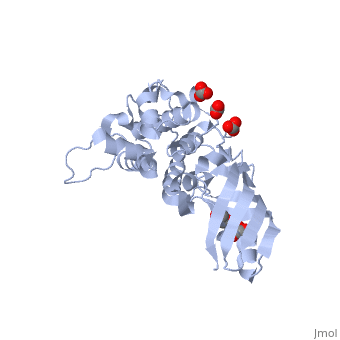Colicin M
From Proteopedia
(Difference between revisions)
m |
|||
| (7 intermediate revisions not shown.) | |||
| Line 1: | Line 1: | ||
| - | Colicin M is a type of [[Colicin]], a bacteriocin made by ''E. coli'' which acts against other nearby ''E. coli'' to kill them by inhibiting synthesis of peptidoglycan, preventing synthesis of the cell wall and ultimately leading to cell | + | <StructureSection load='2xmx' size='350' side='right' caption='Structure of E. coli colicin M complex with glycerol and carbonate (PDB entry [[2xmx]])' scene=''> |
| + | '''Colicin M''' is a type of [[Colicin]], a bacteriocin made by ''E. coli'' which acts against other nearby ''E. coli'' to kill them by inhibiting synthesis of peptidoglycan - murein, preventing synthesis of the cell wall and ultimately leading to cell lysis. <scene name='Colicin_M/Colmsingle/1'>Monomer</scene> of Colicin M. | ||
| + | |||
==Synthesis and release== | ==Synthesis and release== | ||
| + | |||
| + | The operon for colicin M is encoded on a plasmid in the cytoplasm of the E. coli. This operon also encodes its [[Colicin Immunity Protein]], [[Cmi]], to protect the membrane of the cell from the activity of the cytotoxic domain, alongside a protein to aid the release of the colicin outside the cell. When produced, the immunity protein binds to and inhibits the enzymatic cytotoxic domain. | ||
==Mechanism of uptake== | ==Mechanism of uptake== | ||
| + | |||
| + | The receptor binding domain of the colicin binds to the outer membrane receptor FhuA on the target cell; it is a constitutively expressed protein parasitised by the colicin. The translocation domain then recruits proteins from the [[Ton]] system to translocate the protein across the membrane and into the cytoplasm. | ||
==Killing Activities== | ==Killing Activities== | ||
| + | |||
| + | ColM shows enzymatic properties of degradation of lipid I and lipid II peptidoglycan intermediates. The cleavage occurs between the lipid moiety and the pyrophosphoryl groups. This then leads to the arrest of peptidoglycan polymerisation<ref> PMID: 16777846 </ref>, rather than the direct degradation of the peptidoglycan<ref> PMID: 7012126 </ref>. | ||
| + | |||
| + | ==References== | ||
| + | |||
| + | <references/> | ||
Current revision
| |||||||||||

